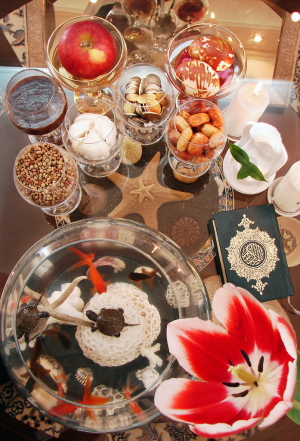SATURDAY, MARCH 20 and SUNDAY, MARCH 21: All across the Northern Hemisphere, men, women and children welcome the season of spring, marked by the vernal equinox. This ancient cycle fuels celebrations worldwide:
- In many parts of the Middle East and Asia, the ancient holiday is known as Nowruz; for Bahai’s, it’s Naw-Ruz.
- For many Hindus, it’s Ugadi.
- For Pagans and Wiccans, it’s Ostara.
Though the names and specific rituals may differ, the theme is joy in the promise of new life that comes in the spring season. As the darkness of winter lifts, communities rejoice. Whether it’s Kurds in Turkey jumping over fires, Iranians sprouting grains or Wiccans discussing the symbolism of the egg, all embrace the rejuvenation of the season.
NORTHERN SPRING AND THE VERNAL EQUINOX
On March 20 at 5:37 a.m. EDT, the 2021 vernal equinox will occur—and for those in the Northern Hemisphere, that signals springtime. Though day and night are not exactly equal in duration on the equinox—that event is known as equilux, and varies by location—the plane of the Earth’s Equator passes the center of the sun on the equinoxes. During the equinox, length of daylight is (theoretically) the same at all points on the Earth.
In Chinese belief, spring is associated with a green dragon and the direction east: the green dragon for the green sprouts of spring, and east as the direction of sunrise and the beginning of each day.
NOWRUZ: THE HAFT-SIN TABLE
Spellings vary widely, but across much of the Middle East, Central and South Asia—Iran, Afghanistan, Iraq, Syria, Turkey, Pakistan, Kazakhstan and more—as well as by Zoroastrians and other religious and ethnic groups, the vernal equinox marks Nowruz, the New Year holiday.
Classified among UNESCO’s Masterpieces of Oral and Intangible Heritage of Humanity, the Iranian/Persian New Year dates back hundreds of years BCE. Many believe that Nowruz is rooted in Zoroastrianism and was started by Zarathustra, though some place the festival’s origin centuries before Zoroaster.
Nowruz dawns as the first day of spring and the beginning of the year in the Persian calendar. Nowruz is a very important holiday in Iran and for Zoroastrians. Extensive spring cleaning begins a month prior to Nowruz, and new clothing is bought in anticipation of the 12-day celebrations that include numerous visits to family and friends. Prior and sometimes during the festival, fires are lit that reflect the Zoroastrian perspective on light’s victory over darkness. Many Iranians put up a Haft Sin table, covered with seven symbolic items. Items vary slightly but may include apples, mirrors, candles, sprouted wheat or barley, painted eggs, rose water, dried fruit, garlic, vinegar, coins and a holy book. Parsi Zoroastrians set up a “sesh” tray, filled with rose water, a betel nut, raw rice, raw sugar, flowers, a wick in a glass and a picture of Zarathustra. On the 13th day of the New Year festival, families head outdoors for picnics, music and dancing.
NAW-RUZ: BAHA’I NEW YEAR
Baha’is have been fasting for the past month, and on Naw-Ruz, that fast is broken—a celebration of the Baha’i New Year. Naw-Ruz was instituted by Baha’u’llah, the founder of the Baha’i faith, as a time for great joy. No set rituals exist for Naw-Ruz, but most Baha’is gather for a meal and read sacred Baha’i writings. Abdu’l-Baha, the son of Baha’u’llah, described the equinox as a symbol of the messengers of God, with their message as the spiritual springtime that is Naw-Ruz.
UGADI: RELIGIOUS FORECAST; SIX TASTES
For Hindus and the people of the Deccan region of India, this time of year bring (Y)ugadi, derived from Sanskrit as “the beginning of a new age.” Names for the festival vary by region, but across India, Ugadi specifically refers to the start of our current age, Kali Yuga. According to Hindu legend, Kali Yuga began in 3102 BCE, at the moment Lord Krishna left the world. On Yugadi, people traditionally gather to listen to the recitation of the religious almanac of the new year—or, in other words, a forecast of the coming year. Hindus used to gather in temples to hear the Ugadi forecast, but today, priest-scholar recitations can be viewed on television or the almanac might be read by an elder in other settings.
On this auspicious day, extended families gather and ritual baths are taken before prayers. Carefully cleaned homes welcome visitors with an entrance draped in fresh mango leaves. In many regions, a dish of six tastes is partaken with a symbolism that represents the varied experiences of life. Most commonly, neem buds and flowers symbolize sadness; jaggery and banana signify happiness; green chili peppers represent anger; salt indicates fear; taramind juice symbolizes disgust; and unripened mango translates to surprise.
OSTARA: PAGANS AND WICCANS CELEBRATE
Symbols of eggs and rabbits illustrate the Pagan and Wiccan holiday of Ostara, known also for the goddess of spring by the same name. Ostara, or Eostre, is the ancient goddess of spring and dawn who presides over fertility, conception and pollination. Symbols of eggs and rabbits represent the fertility of springtime, and in centuries past, these symbols were often used in fertility rituals. The next full moon, also called Ostara, is known as a time of increased births.
As the trees begin to bud and new plants emerge, modern Pagans and Wiccans fast from winter’s heavy foods and partake in the fresh vegetables and herbs of springtime. (Learn more from Wicca.com.) Traditional foods for this time are leafy green vegetables, dairy foods, nuts and sprouts; favored activities include planting a garden and taking a walk in nature.



